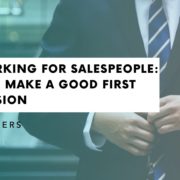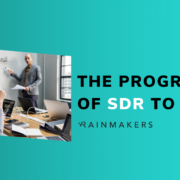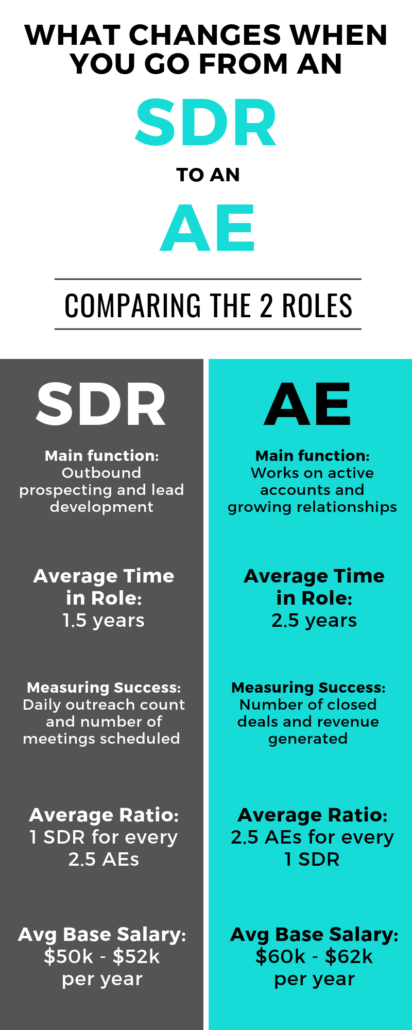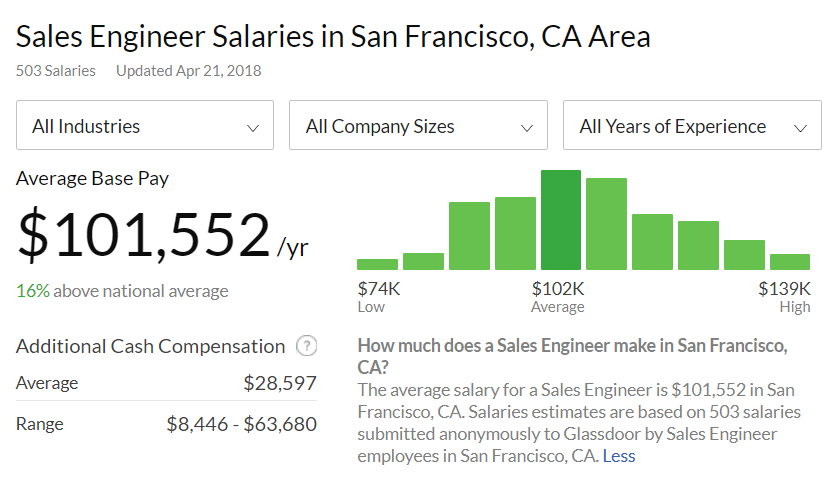Whether you’re attending a career fair, interviewing for a job, or networking with other salespeople and professionals online, your first impression is extremely important. Portraying yourself in a way that emulates you, your skills, and your passion for the field you intend to pursue is necessary for career growth and individual development. To make a positive impact on business professionals and future employers, it’s vital that you come well-prepared. If you’re unsure of where to start, follow these tricks and tips to ensure you make a good first impression.
Fine-Tune Your Résumé
As a salesperson, it’s your job to sell yourself. To do that, you should first begin by fine-tuning your résumé. No matter how many experiences you do or don’t have, all the jobs you apply for and the professionals within these fields will require a certain set of qualifications and expectations from you. Since it only takes recruiters about 6 seconds on average to review a person’s résumé, it’s essential that you take the time to design a well-formatted, detailed résumé before connecting with a person or company. If done correctly, your résumé will emphasize both the knowledge you’ve gained from your previous experiences, as well as act as a supporting resource for you during interviews, business meetings, and other appearances.
Tips to construct a one-of-a-kind résumé:
- Make sure your résumé is only one page – Despite all of the practice you may have had in your field, you should normally aim to keep your résumé to just one page in length. Given the small amount of time it typically takes recruiters to examine your résumé, focus on outlining the experiences most relevant to the job or industry.
- Use a résumé template – Try downloading different résumé templates that customize your past work into sections like education, certifications, related experiences, volunteer work, and more. This will help you fit everything you’d like to include on your résumé without having to spend extra time on the nitty-gritty formatting details.
- Use bullet points – Bullet points are an effective way to highlight the important information you’d like to outline in relation to your résumé’s subsections. A general rule of thumb is to use 3-5 bullet points for each experience listed on your résumé. Unless the category refers to more generic subsections such as your education, skills, or certifications, try to expand on the role you played in each area.
- Bullet point structure – To guarantee your bullet points are elaborate and thorough, follow the bullet point structure: bullet point = action verb + what you did + additional descriptive information/results. For example, think back to your previous responsibilities and involvement at a former company, club, or organization. If you were a cashier at your last job, interacting with customers was probably a major part of your role. So how do you explain that in bullet point structure?
- Action verb: Interacted
- What you did: with 20-40 customers on a day-to-day basis
- Additional information/results: in order to optimize work productivity and sustain company relationships.
Now put it all together – Interacted with 20-40 customers on a day-to-day basis in order to optimize work productivity and sustain company relationships. The concise detail will show how your previous work is applicable to your future career as a salesperson.
2. Create a LinkedIn Account
Living in the ever-changing era of technology offers many advantages to first impressions. By establishing various social media accounts, you’re able to develop an online persona, allowing people to see what you want them to see. That’s why when it comes to career growth and personal advancement, you’ll want to develop your digital footprint by creating a LinkedIn account.
LinkedIn is a social media platform designed explicitly for the professional community. In particular, it allows users to develop their personal brand through the creation of their online profile, explore job openings, and connect both socially and professionally with other LinkedIn users.
Here’s how to create an adequate LinkedIn account:
- Take a professional-looking profile picture – Unlike most media channels, LinkedIn is all about showing off your polished skills. With the digital world upon us, recruiters and employees use this space to get a sense of your credibility and how you imitate yourself online. Salespeople specifically will be especially wary of how you visually represent yourself. That said, your profile picture should be nothing like your online dating profile.
To capture the best picture, there are a few things to reflect on before uploading:
- The photo should be a headshot – Because your LinkedIn avatar will appear smaller compared to the rest of the content featured on your profile, take a clear headshot so viewers can see who exactly they’re looking at. Additionally, to accentuate your features and hide others, keep in mind the lighting of the photo.
- Style your hair – The healthier your hair looks, the more confident and conscientious you’ll appear to others. To avoid appearing disheveled, keep your hair clean, tamed, and out of your face. If you’re suffering from medical conditions relating to hair loss, try solutions like shampoos that promote hair regrowth for women, or a treatment that slows balding in men.
- Avoid selfies – LinkedIn pictures should require effort. Uploading a silly selfie or a picture of you at the beach illustrates that you’re not serious about your image or pursuing a career in sales.
- Structure your LinkedIn profile the same as your résumé – A great way to prove your credibility to recruiters and employees is by reiterating the information mentioned in your résumé and sharing that on your online profile. Fortunately, LinkedIn offers suggested sections for you to fill out in accordance with your interests, making it easier to navigate each area included in your profile. This gives you the chance to expand on the areas you left out in your résumé and be more personable about your experiences.
- Get connected – Another way to show your validity is to get acquainted with other LinkedIn users. Regardless if they are salespeople, your friends, family, old teachers, or past employees, the more connections, the better. Professional relations online help to expand your career opportunities and contacts across the globe. Just before connecting, however, double-check that you know the user reaching out by studying their profile and your mutually shared connections.
3. Be Mindful of Your Physical Appearance
Studies show that the majority of first impressions are based on an individual’s physical appearance. With that in mind, it’s crucial you are mindful of your looks and nonverbal forms of communication.
- Dress for the occasion – Finding the appropriate outfit for the occasion can be tricky because you want to find a combination that fits your personality, feels comfortable to wear, and suits the sales industry you’re in or looking to be a part of. Whatever the circumstances, your goal as a salesperson should remain the same — always dress to impress.
For best practice, consider the following before selecting an outfit:
- Personal brand vs. industry expectations – When choosing what to wear, think back to your personal brand. How does it align with your industry expectations? How can you incorporate who you are in your clothes? Based on your answers, your professional style may vary for different events.
- The type of networking event – Fashion decisions may also alter depending on the type of networking event you go to. Happy hour meetups, for example, are more likely to have a casual “dress code” compared to larger, more structured events such as a corporate conference.
- The people attending the event – Your outfit expectations will likely change in accordance to the people who are also attending. Although you should constantly strive to look your best, it’s unrealistic for you to dress-to-the-nines when the salespeople around you are colleagues and other familiar faces. In these cases, you have the ability to adjust your style to a more laid-back, yet still professional look.
- Nonverbal forms of communication – Communication is not just expressed verbally. Every day, we convey our thoughts and feelings through our body language and other nonverbal forms of communication. Oftentimes, though, our communication can be perceived the wrong way by others.
To keep your nonverbals in-check, pay attention to your smile and your level of eye contact.
- Smile – Preserve your pearly whites! A person’s smile is one of the first things people look at and is recognized as one of the most memorable features. Healthier-looking, clean teeth can make you appear more successful to others, according to research. Be sure to brush your teeth and floss before meeting in-person with professionals, other salespeople, and clients.
- Eye contact – With anyone you talk with, you’ll want to make sure you’re maintaining eye contact with them because it communicates warmth and honesty, as well as your level of interest. Just be sure not to gaze off at the person for too long — only about three seconds at a time.
4. Keep Track of Your Network and Stay in Touch
At the end of the day, networking for salespeople is all about building relationships with those who are willing to share their professional knowledge with you. Whether it’s a connection made online or in-person, the people you meet and the exchanges you have can have a direct impact on your career in sales. For this reason, you must strive to keep track of your network and remain in touch with those you’ve had the privilege of communicating with and learning from. In doing so, you’ll be able to turn that first impression into a lasting impression.
- Keeping track of your network – Record the names of those you’ve networked, the company they’re associated with, and their phone number or email. Store this information either electronically or on paper and keep it in a safe place. Another way to manage your networks is by holding on to business cards and paying close attention to whom you give your own card too.
- Stay in touch – The purpose of keeping track of your networks is not for you to reach out to professionals when you’re in a pinch with your job or need something in particular. Instead, this information is intended for you to continue to develop and strengthen your interpersonal relations with these salespeople. A simple email to check-in and say hello or a note to say thank you can really go a long way.
Conclusion
The best first impressions are the ones that demonstrate your positive traits and individuality. Doing these simple things when you network with people can support your ability to make a positive influence as a salesperson and further your career growth over time.























